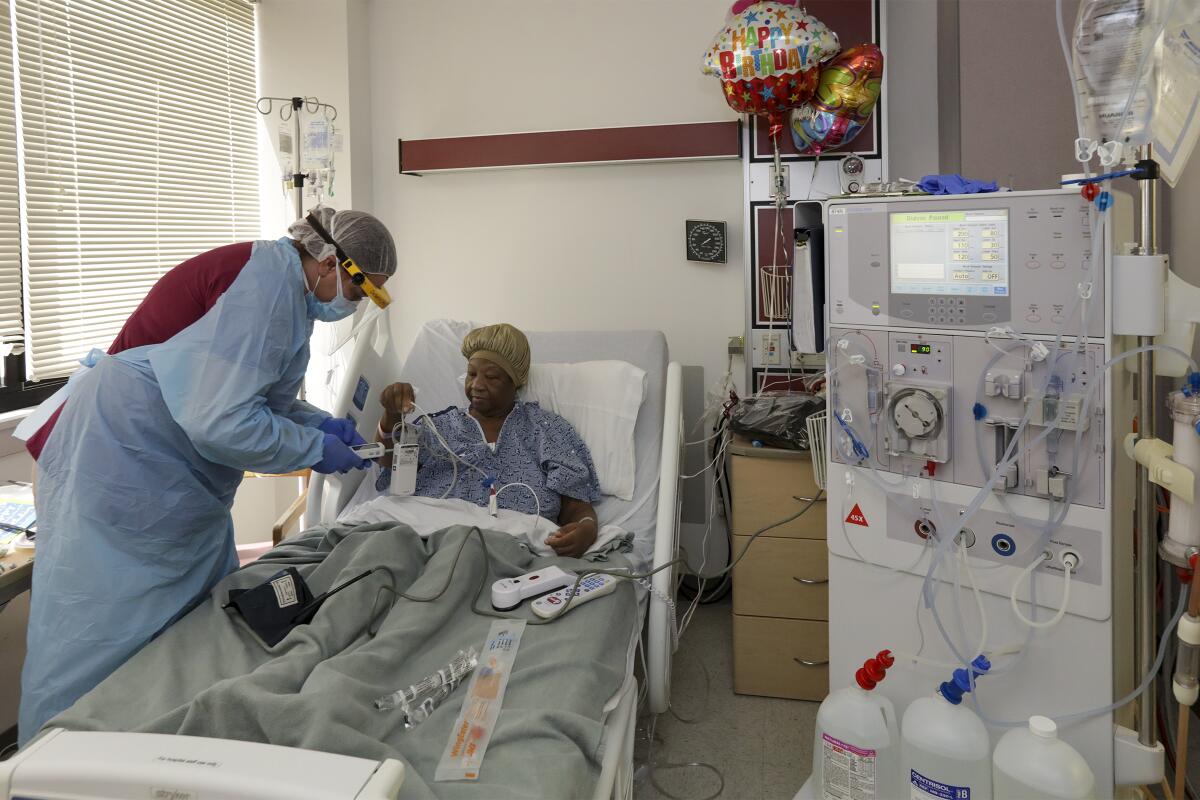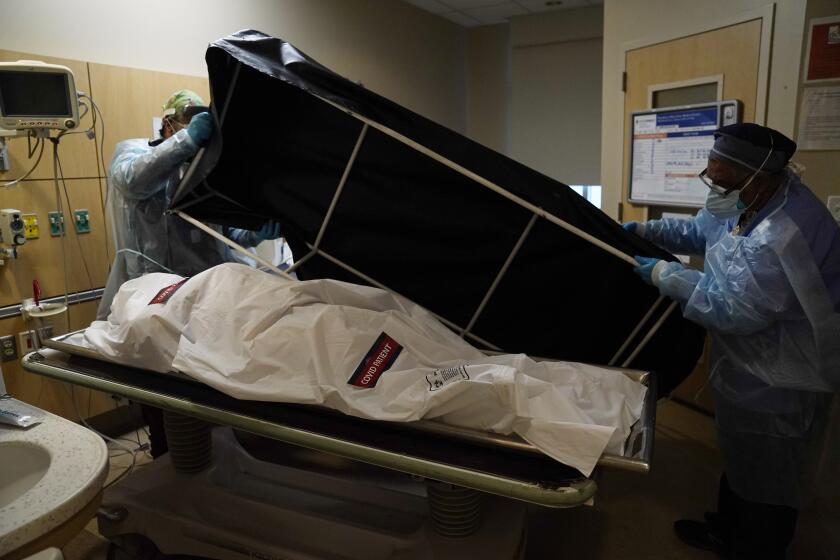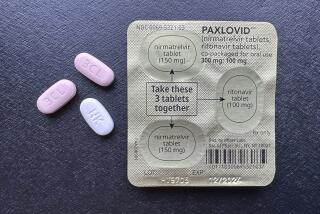Vaccines are terrific, but where are the COVID-19 treatments?

- Share via
Since the early days of the pandemic, we’ve all wanted to know when and how it will end.
Many of us assumed that COVID-19 vaccines were the answer, and the U.S. government poured more than $18 billion into Operation Warp Speed to develop and test them. That research has yielded three authorized vaccines — so far — that are highly effective not just against the original virus but also against its many variants, including the highly transmissible Delta variant.
And yet the pandemic lingers.
Fortunately, vaccination is only one part of the solution. Researchers are also experimenting with a wide variety of medicines that can help reduce hospitalizations and deaths due to COVID-19. These, too, could bring the pandemic to an end.
But it won’t be easy.
“Viruses mutate easily, so they are usually very quick to escape any therapeutic intervention,” said Juliet Morrison, a microbiologist at UC Riverside. “Any antiviral should target multiple aspects of the viral life cycle so you don’t select for resistance.”
That means finding a single pill that can disrupt not just how the coronavirus gets into cells but also how it copies itself. It should also be able to deal with the shell the virus makes to protect its precious genetic code.
“There are like 30 different proteins that SARS-CoV-2 encodes for, and all of those are potential targets,” Morrison said.
Scientists have found 13 places in the human genome that may influence our susceptibility to a coronavirus infection or risk of severe COVID-19.
When it comes to the most serious cases of COVID-19, it’s important to know that it’s not the virus itself that puts people in the ICU, but rather the immune system’s response to the virus, Morrison added.
That means the most effective treatment would stop the coronavirus before it makes the immune system go haywire. But that would have to happen early on — in many cases, before people even know they’re infected.
“That’s a big issue,” she said.
Scientists are determined to succeed in spite of these obstacles. In June, the Biden administration announced a $3-billion investment to accelerate the discovery, development and manufacturing of antiviral medicines for COVID-19 patients. The ultimate goal is to create a pill that could be prescribed immediately after a patient receives a positive coronavirus test result.
Two decades of progress in closing a yawning gap between the life expectancy of Black and white Americans has been erased by COVID-19.
It may sound like a tall order, but experts say this could happen by the end of the year.
“I am very hopeful,” said Dr. Aneesh Mehta, chief of infectious diseases services for Emory University Hospital. “We have some very good candidates.”
Until then, doctors will have to rely on therapeutics that were created to treat other diseases.
Mehta spoke to The Times about which medicines are currently available to COVID-19 patients, how the disease will be treated in the future, and how the effort to create an antiviral drug capable of stopping the coronavirus could also help prevent — or at least shorten — other pandemics in years to come.
How are doctors treating people with mild cases of COVID-19 now?
If you have COVID-19 and are mildly ill, using monoclonal antibodies [proteins that mimic the body’s own immune defenders] is a great option.
Those have decreased the number of patients needing to go to the hospital, and the good news is one dose should be enough to cover your treatment for the course of COVID.
But not everyone can get them, right?
One of the important limitations is that they almost always have to be given through an IV, so generally we only use those for patients with risk factors like cardiovascular disease, diabetes, lung disease and in the elderly.
If they continue to work down the road, we may broaden their use.
What about treating very ill patients?
For patients sick enough to be in the hospital and on oxygen, there are two types of treatments recommended by the National Institutes of Health.
One is anti-inflammatory, which dampens the immune response. The other is an antiviral, which works by directly stopping the virus from replicating.
Let’s start with the anti-inflammatory approach. What drugs are these?
The main anti-inflammatory we use is dexamethasone, a steroid used for many other conditions. It has been demonstrated to decrease the risk of dying from COVID if you are in the hospital and on oxygen.
Baricitinib, which is used for rheumatoid arthritis and other autoimmune diseases, is more expensive, but we use it in some patients who can’t use dexamethasone. Those are the two main anti-inflammatories used in the U.S.
What antiviral drugs are you using?
Remdesivir is approved for patients who are in the hospital and on conventional oxygen through nasal prongs. For sicker patients, it may not be as effective.
Do you ever combine these two approaches?
Yes. We generally use them together so we are attacking both the virus and the inflammation that the virus creates. For the majority of people, the combination decreases the risk of death and the amount of time they are in the hospital.
Are there any other treatments?
Tocilizumab, which blocks a chemical system in the body that leads to inflammation, may reduce the risk of death in patients who are rapidly progressing to being in the ICU.
The World Health Organization recently said drugs like tocilizumab reduce the odds of death by 13% compared with standard care. Honestly, that doesn’t sound like much.
The reduction of risk is moderate, but for certain patients, it can be a very useful tool.
Just like everything else in COVID treatment, there are no magic bullets. It requires medical teams to use every tool in the arsenal to help patients, and that includes supportive care.
So far, COVID-19 drugs have mostly been tested in hospitalized patients. Can they also help patients with more mild disease?
In the start of the epidemic, the vast majority of clinical trials were in patients sick enough to be in the hospital. But as we know, that was only the tip of the iceberg of patients.
There has been a big push recently — here in the U.S. and globally — to study treatments for those not sick enough to be in the hospital. Antivirals and monoclonal antibodies may be more effective early on in the disease; this is really an important area for us to explore.
We are also exploring how to get these medicines so patients can use them at home and not use up vital hospital space.
How hard is it to convert an IV medication into pill form?
That’s a question many of us have. Doctors would rather give patients things that are easier for them to take. But there are difficulties in getting some of the biochemical agents into a form stable enough to make it through the digestive tract and throughout the body.
We do have antiviral pills in clinical trials now. But the monoclonal antibodies are hard to deliver as pills because they are a protein that can become unstable in the wrong conditions.
Government scientists have said they hope to see an antiviral pill by the end of the fall. Does that seem possible?
I am very hopeful we will have an oral antiviral medication for people with COVID by the end of the year. We have very good candidates, including molnupiravir, which was developed at Emory.
We would love to be in a situation like we are with influenza, where patients are diagnosed in a clinic or urgent care and then given a prescription for a pill that they can take at home that will prevent them from getting any sicker.
It seems like many people assume the next pandemic will be caused by a virus too. Why is that?
The next pandemic could come through bacteria or fungi, but most likely it will come from a virus. It’s easy for them to spread. They are small, they are hard to detect, and there are various ways they can infect the body and run through the body.
That’s why it’s important we have a fundamental pandemic preparedness plan that includes surveillance for new viruses and good platforms for developing treatment for these viruses, and the ability to test them very rapidly.
We have to learn from each pandemic how to be better prepared for the next one.
This interview was edited for length and clarity.








